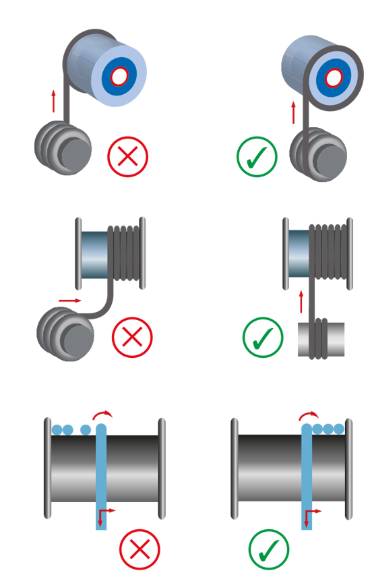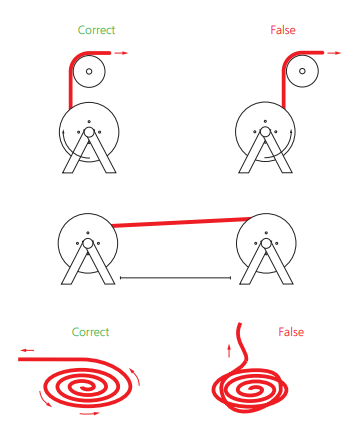Anhui Feichun Special Cable Co.,Ltd Li.wang@feichuncables.com
What Are the Key Steps in Installing Reeling Cables for Mining and Industrial Applications?
Explore the essential installation guidelines for reeling cables in mining and industrial sectors. Learn about the best practices for proper cable handling, installation, maintenance, and troubleshooting.
Li.wang@Feichun Cable
7/8/20254 min read
Reeling cables are essential components in industries such as mining, construction, and manufacturing, where they are used to supply power to equipment that undergoes frequent movement. These cables are designed for dynamic applications, ensuring reliable power transmission under continuous motion. However, their effectiveness and longevity heavily depend on proper installation practices.
This article aims to provide a comprehensive guide on the installation, maintenance, and troubleshooting of reeling cables, with a particular focus on the unique conditions in South African mining operations. By understanding and following the installation guidelines, engineers and operators can ensure a longer service life, reduce downtime, and enhance safety on-site.
Key Considerations for Reeling Cable Installation
Proper Cable Handling:
Unwinding and Storage: Reeling cables should be unwound directly from the supplied drum onto the reeling drum, following a straight, torsion-free path. It's crucial not to completely unwind the cable, as this can lead to tangling and physical stress.
Avoiding Physical Damage: During installation, cables must be protected from external damage, including sharp objects, chemicals, and extreme weather conditions.
Torsion-Free Installation:
Guiding the Cable: Reeling cables should always be installed in a way that prevents twisting and torsion. The cable should follow a straight path, with minimal movement, ensuring that no twisting occurs.
Stranding Direction: Reeling cables must be wound in the correct direction of stranding (Z-lay direction for right-side operation). If the direction is unknown, it’s recommended to consult with technical support for guidance.
Bending Radius:
Minimum Radius Adherence: Every reeling cable comes with a specified minimum bending radius. Exceeding this radius, either during installation or operation, can cause long-term damage, reducing the cable’s lifespan. It's essential to maintain these specifications throughout the cable’s service.
Tensile Stress:
Load Limits: Reeling cables are designed to withstand a certain level of tensile load. It’s crucial not to exceed 15 N/mm² for copper conductors unless otherwise specified. Overloading the cables with higher tensile stress can lead to deformation and eventual failure.
Dynamic and Static Loads: During installation, both dynamic and static tensile loads should be considered to avoid over-stressing the cable.
Installation Process
Unwinding and Mounting the Cable:
Correct Method for Unwinding: Begin unwinding the cable directly from the supplied drum to the reeling drum. Ensure that the cable is unwound without unnecessary twists or turns. Always make sure the cable is securely fixed without twisting.
Number of Windings: When fully extending the cable, at least two windings should remain on the reeling drum to ensure the cable stays properly secured.
Reeling Mechanism Setup:
Drum Installation: The reeling drum must be securely mounted to ensure smooth operation and prevent any undue stress on the cable. It’s essential that the reeling system is set up according to manufacturer guidelines.
Torsional Stress Mitigation: During operation, torsional stress can occur due to the rotation of the reeling drum. While some torsion is inevitable, exceeding a 25°/m torsional limit can drastically reduce cable lifespan. Hence, minimizing this stress is crucial.
Guiding the Cable:
Using Roller Packs and Guides: Guide rollers should be installed along the path of the cable to prevent unnecessary bending or abrasion. These rollers help maintain the cable’s alignment, reducing friction and wear over time.
Correct Alignment: Ensure that the cable follows a direct, controlled path from the drum to the equipment, minimizing any sharp angles or tension.
Post-Installation Testing and Maintenance
Testing the Cable:
Electrical Continuity and Insulation Tests: After installation, conduct electrical tests to ensure there are no faults in the cable. Verify insulation resistance and check for any short circuits that could pose a safety risk.
Mechanical Stress Tests: Perform mechanical tests to check if the cable has withstood the tensile and torsional stresses without any degradation.
Routine Maintenance:
Monthly Inspections: To maximize the lifespan of reeling cables, it’s recommended to perform a detailed inspection at least once a month. Inspect the cable for signs of physical damage, wear, or abrasion, especially at high-contact points like cable guides or rollers.
Lubrication and Cleaning: Clean the cable regularly to prevent dust, dirt, and moisture buildup. Lubricating the cable and roller mechanisms can reduce friction, extending cable life.
Twist Removal:
If axial twists occur during operation, they should be corrected immediately to avoid damage to the cable. A regular check for twists will help prevent long-term issues.
Troubleshooting Common Issues
Cable Overload or Tension Issues:
Problem: Exceeding the tensile stress limits can lead to deformation or breakage.
Solution: Monitor the load during cable operation to ensure it does not exceed recommended limits. Regularly check for signs of stretching or deformation.
Excessive Torsion:
Problem: If torsional stress exceeds 25°/m, the cable’s lifespan can significantly decrease.
Solution: Use torsion-resistant cables or install systems to minimize the rotation of the reeling drum. If torsion is unavoidable, ensure the cable is designed to withstand it.
Bending Radius Exceedance:
Problem: Undercutting the minimum bending radius leads to internal damage and reduced cable performance.
Solution: During installation and use, ensure that the cable is not bent beyond its specified limits. Use proper guiding systems to maintain the correct radius.
Cable Wear and Tear:
Problem: Reeling cables may wear out due to prolonged exposure to harsh conditions, such as high temperatures or chemicals.
Solution: Regularly inspect the cable for any signs of damage. Implement a cable replacement schedule if wear becomes noticeable, and ensure that the cables are protected from environmental damage.
Conclusion
Proper installation and maintenance of reeling cables are essential to ensure that mining and industrial operations run smoothly, safely, and efficiently. Following the guidelines for unwinding, bending, tensile load limits, and torsional stress can extend the service life of the cables and prevent unexpected failures. Regular inspections and proactive maintenance will further safeguard the cables against wear, ensuring that they continue to perform optimally under harsh conditions.
In South Africa’s mining sector, where equipment is subjected to constant movement and environmental stress, investing in high-quality reeling cables and adhering to these installation practices is crucial for ensuring operational success and minimizing downtime.





Email Address: Li.wang@feichuncables.com
© 2025. All rights reserved.


One-click to Quickly Contact
Products
Offshore & Marine Cable
XLPE Cable
Contact
Company
Location:
Building A Private Science and Technology Park, Hefei Economic and Technological Development Zone, Anhui Province, China
